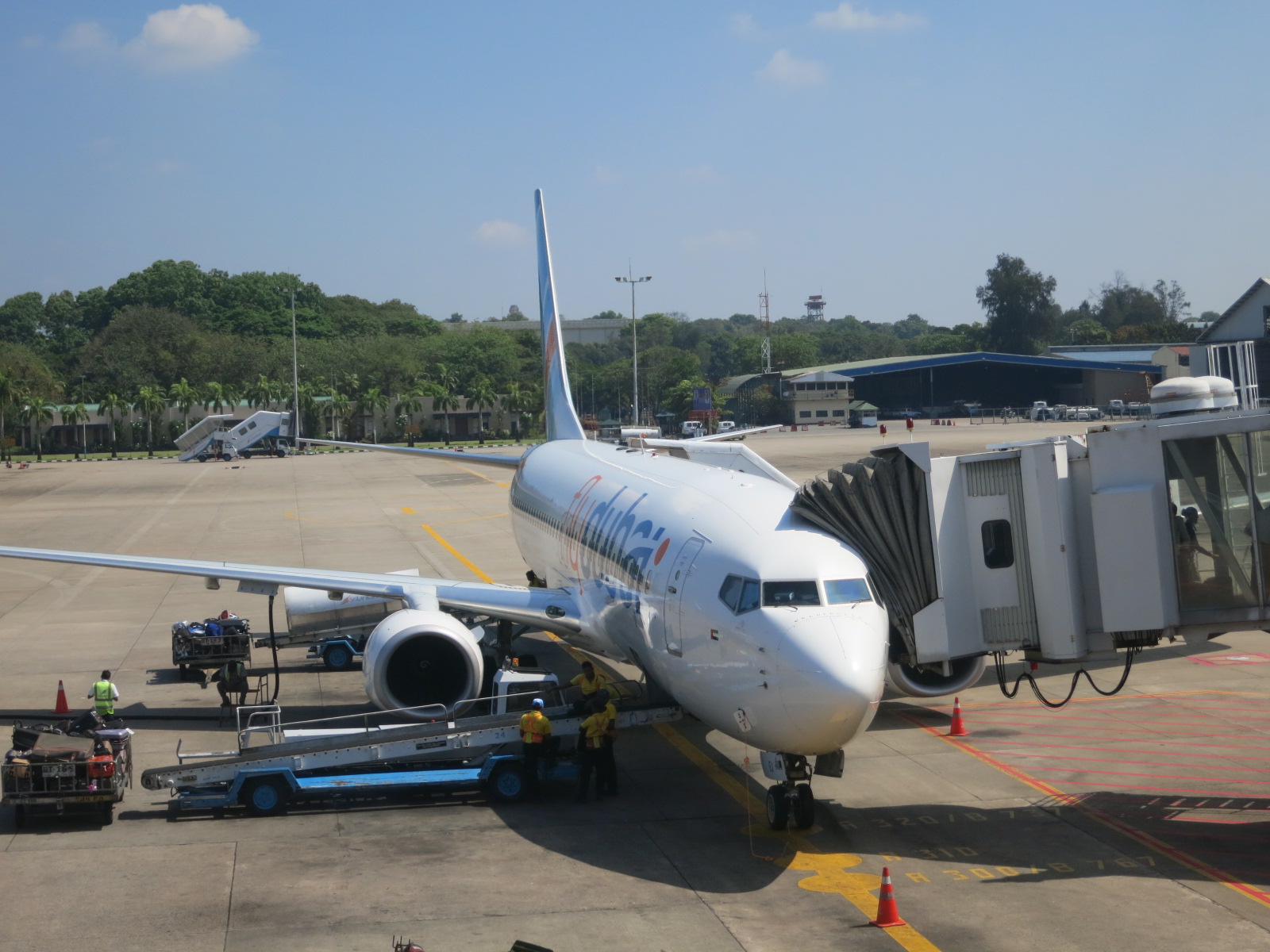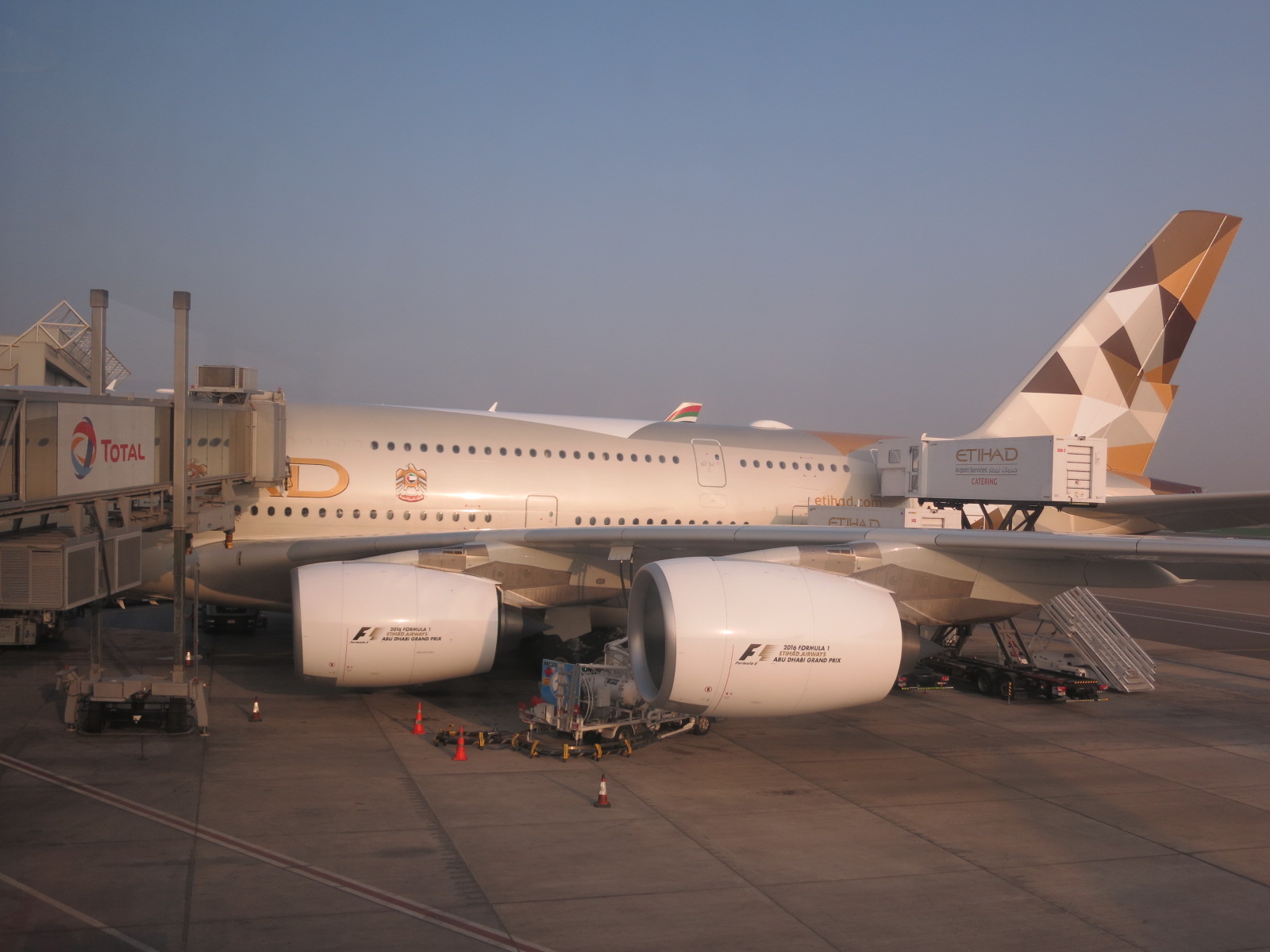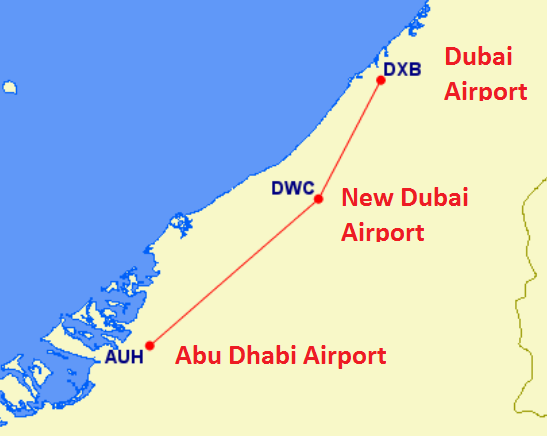Last year there was a report that Emirates and Etihad were considering merging. Then in the fall Emirates CEO Tim Clark said he was open to working with Etihad, and offered a non-denial denial about a likely merger. Now there’s a new modest agreement the two airlines have entered into — signed by their CEOs.
Energy prices are down, meaning that travel to the Gulf region is down. At the same time, there’s less of an appetite to absorb losses.

Emirates hasn’t been losing money but profits are down. Etihad has been hemorrhaging largely from investments in basket case airlines air berlin and Alitalia that they walked away from. The CEO who was the architect of this strategy was let go. Seat capacity out of Abu Dhabi is down about 10% year-over-year.
Meanwhile the region is now also starting to see increased competition from ultra low cost carriers. Emirates is adapting by working more closely with government-owned flyDubai.

Now Emirates and Etihad have entered into an agreement to share security information and for Emirates to provide training programs to Etihad. And it was handled directly by the CEOs of the two airlines.
Monday’s memorandum of understanding involves Emirates unit Emirates Group Security and Etihad parent Etihad Aviation Group working “together on operational areas both within and outside the UAE,” according to an Emirates statement.
The agreement was signed by Emirates President Tim Clark and Etihad’s new Group Chief Executive Tony Douglas.
While speculation of a merger has been a parlor game dating back a decade, it’s not clear that it makes any sense for any airline to operate major hubs a mere hour’s drive away from each other. Bringing the two airlines together would almost certainly mean a de-emphasizing of Abu Dhabi.

Indeed it was the de-emphasizing of Gulf Air’s Abu Dhabi hub in the first place that led the Al Nahyans to start their own airline in the first place.
Yet Dubai’s new Al Maktoum International Airport is even closer to Abu Dhabi and could make a single hub more palatable.

In the fall the CEO of Emirates said “there is value to be had working more closely with” Etihad. But ultimately it’s not a call that the CEOs of the two airlines will make, it’s up to the ruling families of Dubai and Abu Dhabi.


The unsustainability of the Middle East airlines has been obvious to everyone in the industry for a decade. For the heavily-subsidized-but-at-least-remotely-plausible Emirates operation to continue, they will need to downsize their even-less-plausible local competitors. If Etihad exists in its current form in a decade, I’ll be amazed. Consolidation with Emirates is obviously their best strategy. Liquidation is probably the only alternative (assuming the Emirs can’t continue to float the multi-billion dollar annual subsidies forever, which I think is a reasonable assumption).
@iahphx you realize that should require you to revisit your priors on protectionism for Delta, American, and United right?
Clearly they are scaling back, cutting costs, revisiting routes based on economics. And it undermines the claim that the world’s most profitable airlines “can’t compete against governments.” Gosh, if they can’t compete even against GOVERNMENTS what use are they?
The whole notion of an omni-powerful DWC only works if both the existing DXB and AUH hubs are closed and force moving all tenants over. Simply moving EY up to DWC doesn’t really change anything other than semantics.
Maybe EK can magically defy gravity, but it’s hard to imagine that the A380-based super-connector system won’t take a hit if EK splits their hub ….. *unless* the emir declares a perimeter rule for the old DXB to protect EK. And if they’re smart, that perimeter would *just* exclude any part of India (the way the LGA/DCA perimeters just manage to squeeze DFW+IAH in but conveniently excludes AUS)
Thanks Gary on calling out iahphx that was my first thought when reading their post. Now having said that if these two were to merge what is the difference than as we have witnessed here in the US of mergers of competitors ? Look at the latest tax changes anyone think that does not scream of subsidies and yet the product from DL/UA/AA continue to decline internationally and oh yes what about Parker’s desire to cramp people into his new metal.
NO we need the ME3 or any variance we see in the future, frankly I prefer flying their metal along with AF and BA to ours. I am booking my next trip which looks to be BA or AF over then EK coming back around.
@Gary — Your comments on this issue are simply nonsense now. But I would think you are smart enough to know this.
As I have always said, the ME3 airlines will eventually self-destruct because no one can afford to lose billions indefinitely. Their free-market competitors, of course, would prefer for them to cut back sooner rather than later, as any rational competitor would. In extreme cases (not really applicable to the US carriers, due to the poor geography of flying through the Middle East from the USA), there is a real risk of being driven out of business before your subsidized competitor has to operate with real-world economics.
So the idea that trying to lose less money somehow proves the ME3 airlines are actually “for profit” is, well, just idiotic. It would be like arguing that Sears and Kmart closing stores every month shows how profitable their business model is. Every money-losing enterprise, even a heavily subsidized one, eventually needs to lose less money.
“The unsustainability of the Middle East airlines has been obvious to everyone in the industry for a decade.”
@iahphx: Emirates is profitable.
“Consolidation with Emirates is obviously their best strategy.”
@iahphx: I hope everyone in the industry is up-to-date with your thinking.
BTW, for any rational readers who want to understand how bizarre the ME3 situation is, it’s worth comparing the widebody fleet of Emirates to American Airlines. American — the largest airline in the world based in the richest country in the world (USA population 321 million) — operates 149 widebody international aircraft. Emirates, which operates out of a country with less than 1 percent of the USA population, has 244 widebodies, and those aircraft are generally much larger than the aircraft operated by AA.
AA can also feed these international flights with about 800 domestic aircraft. Emirates has no domestic fleets, and hence no domestic feed. Emirates must also compete with other nearby nation states with ridiculously outsized airlines: Qatar (209 mostly-widebodied aircraft for a population of 2.5 million), and Abu Dhabi (112 aircraft for 1 million people).
If these numbers doesn’t suggest to you that billions of dollars in annual subsidies are necessary to keep these airlines afloat, I would suggest you not enter the field of airline finance.
@iahphx: National population is irrelevant. Or China would have the largest fleets. The Chapter 11 Three are the oddities. Why is government bailing out airlines of all industries? Let them go down and more efficient replacements will arise from the ashes.
BTW, for anyone who thinks the USA is somehow an unfair comparison to Dubai, I’d note that Singapore Airlines has a fleet less than half the size of Emirates and its nearest competitor in Kuala Lumpur has a widebody fleet of 25. And Singapore and Malaysia both struggle to be profitable, while operating in a region (Southeast Asia) with 3 times the population of the Middle East.
Facts are stubborn things, but people who benefit from subsidies tend to be even more stubborn.
EK has strategic geographic location for connecting traffic and good product. The vast majority of their customers are not residents of the UAE and not interested in visiting Dubai.
The fact the country has a small population doesn’t prove they are subsidized…it just proves they have a lot of connecting traffic. Icelandair has been doing this for years, no one claims they are subsidized because only 300,000 people live in Iceland.
The iahphx troll is back spreading his lies.
Gary, you should pull a “FlyerTalk” and ban him using IP blocking.
Firstly, comparing Singapore Airlines to the ME3 is definitely NOT an apples-to-apples comparison.
Let’s start with the obvious, and then add one other NOT insignificant relevant issue:
1.) [the obvious one] GEOGRAPHY…Singapore Airlines’ hub is beyond the reach from virtually everywhere in the USA of ANY aircraft that would make the type of hub economics that it needs to be a hub on a par with most other airlines, and especially the ME3. If one lacks meaningful access to the world’s largest aviation market, and its (still, but maybe not much longer) largest economy, as SQ does, then its need for wide-body aircraft is going to reflect that.
Period.
Specially configured A340s of the past, or specially configured A350ULRs of the future, simply do NOT allow for Chengi Airport to be a viable hub for SQ, let alone a super-connecting hub;
2.) The proliferation of many other airlines in the region, many of whom CAN fly “off the rack” (as in NON-specially configured) aircraft between their hubs in the region, and major cities and/or alliance partners’ fortress hubs in the USA.
Some prominent examples, of course, would be Cathay Pacific, Korean Air, EVA, Air China, All Nippon Airways, to name but a few…and that’s BEFORE noting the exceptionally generous 5th Freedoms our domestic airlines enjoyed for decades to operate hubs in Tokyo that have now been offset by immunized alliances with all of our remaining Big 3 Oligopolist (crybaby) airlines that pay obscene amounts of salaries to CEOs who demand we fly under abusive, even sadistic, conditions that he, his family, and surely the Board of Directors NEVER, EVER fly themselves that allows for them to be paid such obscene amounts of money in their first place.
So, for those who comstantly whine anout the “unfair” advantages of the ME3, please at least get your facts straight.
Our airlines are already enormously profitable, and the LAST thing they need is even less competition.
Anyone who has followed the industry as long as I have, has actually worked in several industry related capacities as I have, and who has flown as long as I have in virtually all classes of service (except International PE in its current iteration thus far) knows just how sadistic, arrogant, abusive and greedy our airlines have become in the years since their GOVERNMENT SUBSIDIZED BANKRUPTCIES; their favorable “TAX ‘PREFERENCES’ in a variety of ways (and I speak of this as the principal researcher, data analyst and Project Manager who worked on multi-year consulting assignments that specifically focused on tax issues for some of the biggest names in the biz) which are also a form of taxpayer, or GOVERNMENT, SUBSIDIZATION; plus, of course, the latest expansions of TAXPAYER FUNDED CORPORATE WELFARE (aka tax “cut”) that our airlines are now enjoying.
Oh, and please, don’t even get me started about the GOVERNMENT SANCTIONED OLIGOPOLY that’s facilitating the HUGE TRANSFER OF WEALTH from consumers to the overpaid, greedy CEOs who peddle lies constantly justifying ever greater product degradations that they, their families, or the Board of Directors they report to NEVER, EVER experience the way most of us do.
What we DESPERATATELY NEED NOW IS ONE OF THREE THINGS:
1.) New entrants seeking to offer better products, say the way Jetblue originally did, or as Virgin America did until it was bought by another airline, Alaska, that Dominic Gates of the Seattle Times, just this past weekend wrote an article is now being targeted for product degradations similar to those already undertaken at our Big 3 AWFUL airlines, and now underway at once great, but now extremely shady, Jetblue (anyone else notice how its now often MORE EXPENSIVE to buy a “Blue+“ fare bundle with the checked bag included than a regular “Blue” fare and then pay the checked bag fee separately? Ah, yes, can a “Basic Economy” fare on Jetblue be far behind now that cabin densification is underway??? Just sayin’…).
So, with the financial community having a complete, “top to bottom” stranglehold over the airline industry, and finally having achieved an iron grip to control prices, product quality and capacity, new entrants offering something better is highly unlikely;
2.) Vigorous anti-trust enforcement, perhaps even the forced divestitures of gates, take-off and landling slots, or even the breaking apart of the Big 3.
Alas, and certainly until 2021 at the earliest, NOT GONNA HAPPEN;
3.) Reregulation…naturally, my preference is market oriented solutions, or number 1 with NEW ENTRANTS seeking to do as David Neeleman set out to do with Jetblue, or Sir Richard Branson did with Virgin America, create new entrants that compete by seeking to offer something better.
Unfortunately, as most people understand, the sources for seed money are now the very same entities that benefit extraordinarily from the LACK OF COMPETITION we now have, and in fact, are in so many ways the ones who are agressively pursuing the race to the bottom most of us now experience when we fly.
So, REREGULATION is likely going to be the only solution. And quite frankly, REREGULATION can’t come soon enough given how little value is offered, and how product degradations are now becoming a form of extortion to rationalize, or even justify the price gouging I know I’m now experiencing virtually EVERY TIME I FLY.
It’s gotten out of hand…and it’s only getting worse…REREGULATION WILL ULTIMATELY BE REQUIRED TO KEEP THESE ABUSES IN CHECK SINCE OUR AIRLINES CURRENTLY ACT WITH NEAR IMPUNITY GIVEN THAT THEY LACK MEANINGFUL COMPETITION.
Oh, and every day our airlines, all of whom are PROTECTED BY OUR GOVERNMENT from meaningful competition since foreign companies cannot emerge in this industry the way they have in many others (think autos or consumer appliances, etc.), our domestic airlines also enjoy a FORM OF GOVERNMENT SUBSIDIES the ME3 could only dream of having for themselves:
the world’s largest aviation market in the world’s largest economy COMPLETED PROTECTED from foreign (and of late, even domestic) competition.
Yeah, our airlines aren’t GOVERNEMENT SUBSIDIZED…if anyone believes THAT, there’s an iconic bridge near my home I’ll be more than happy to sell you…that or some swampland in the Florida Everglades…your choice!
@Howard — I didn’t make it through your entire rant, but our insanely efficient US airlines still have profit margins well below 10%. And that’s with providing customers with pretty basic (but efficient) service. The idea that more competition would somehow result in fantastic, cheap air service is about 100 times more ridiculous than the idea that the ME3 “make money” with their obviously-subsidized business model.
Thanks for a series of well-put points, @Howard Miller.